What Does a Credit Card Skimmer Look Like? 7 Ways to Spot One

Don’t panic, but criminals would love to get their hands on your credit or debit card. That’s not exactly breaking news: Your cards are an easy way to spend your money and drain your accounts. To avoid putting our finances at risk, we’re quick to cancel our cards when we notice them missing, but scammers have gotten savvier over the years, figuring out how to access your data without ever actually pocketing your card. One of the most common ways they do this is by using a credit card skimmer. These devices collect and share your card information with scammers, so it’s important to know exactly what you’re up against. But what does a credit card skimmer look like, and how can you spot one? Read on for our expert-backed guide.
RELATED: Credit Card Skimmer Found at Another Walmart Self-Checkout—How to Protect Yourself.
What Is a Credit Card Skimmer?
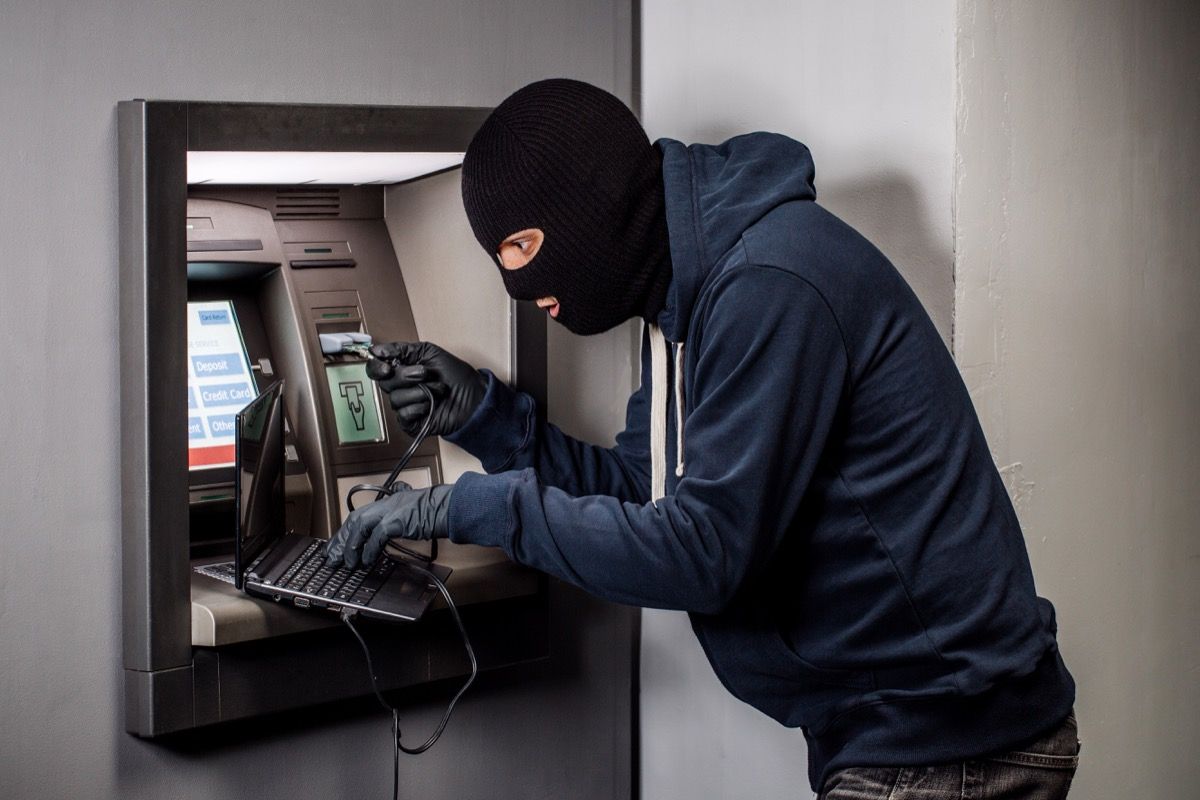
This first step for keeping yourself safe from a credit card skimmer is knowing exactly what it is. Simply put, it’s a “sneaky device made to steal information from the magnetic stripe of your credit or debit card,” Dhanvin Sriram, former financial analyst and cyber security expert, tells Best Life.
The use of these devices dates back to at least 2002, when CBS News reported that around 80 people had gotten their information stolen from a singular card skimmer. Up until that point, people like California prosecutor Howard Wise told the news outlet that they “thought skimmers were an urban myth.”
What Does a Credit Card Skimmer Look Like?
While credit card skimmers can vary in design, they typically tend to be “small, discreet devices that are either attached to or fit over a payment terminals’ card reader slot,” according to Josh Amishav, founder and CEO of the data breach monitoring platform Breachsense.
“Some skimmers are incredibly sophisticated, perfectly mimicking the appearance of the actual card reader, making them hard to detect,” Amishav says. “Others are clumsily fitted or have slight color mismatches or additional overlays that help give them away.”
Where Are Credit Card Skimmers Usually Placed?
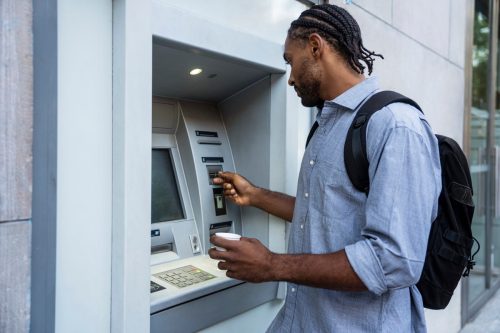
With credit card skimmers, scammers are often trying to get as many victims as possible without being caught. They will “typically install skimmers in places with a high volume of transactions but limited supervision,” Andrew Latham, certified financial planner with SuperMoney.com, explains. This includes gas station pumps and public transport ticket machines.
“Usually, gas pump skimmers are placed out of view of the station administrator,” Bill Ryze, certified chartered financial consultant and board advisor for the financial services company Fiona, notes.
ATMs are also a popular target for credit card skimmers, “particularly those that are not located within bank branches,” according to Amishav.
“While retail stores and restaurants can be involved in skimming scams as well, the chances are less because the terminals are generally under the direct supervision of the staff,” Ryze adds.
RELATED: 5 Credit Cards That Will Actually Save You Money on Gas, Experts Say.
How Do Credit Card Skimmers Work?

It is estimated that skimming devices steal more than $1 billion from financial institutions and consumers every year, according to the Federal Bureau of Investigation (FBI). But how exactly do skimmers give access to your information?
“When a credit card is swiped through a skimmer, the device reads and records the data embedded in the magnetic stripe of the card. The stripe contains the cardholder’s name, card number, expiration date, and the CVV code,” Amishav explains. “Some more advanced skimmers also capture the user’s PIN if it’s entered on a compromised keypad.”
Criminals will then take that information and use it for themselves, or sell it to others for a profit, according to Jonathan Feniak, a financial expert and lawyer licensed to practice in both Colorado and Wyoming.
“Once scammers have that data, they can use your card for all sorts of purchases, especially online, where they can input your data with a few keystrokes,” Feniak shares. “They can even make counterfeit cards that are essentially a copy of the original in your wallet.”
7 Ways to Spot A Credit Card Skimmer
“Card skimmers aren’t always easy to see, which is why fraudsters have been able to steal over $1 billion annually,” Mark Pierce, accountant, attorney, and founding partner of Wyoming Trust and LLC Attorney, cautions.
That doesn’t mean all hope is lost, though. There are several red flags that could indicate a payment terminal has been compromised. In fact, here are seven different ways to spot a credit card skimmer.
RELATED: 5 Ways Your Credit Card Is Ruining Your Finances.
1. Wiggle the card reader.
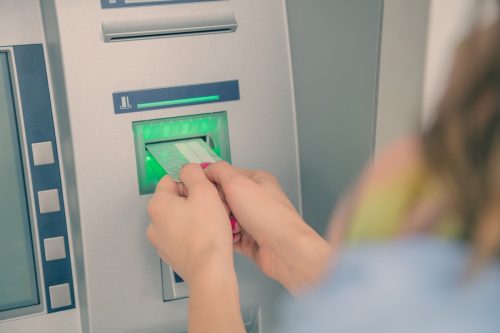
The first thing you should do before using any card reader is gently wiggle it, according to Latham.
“A loose fit could indicate the presence of a skimmer,” he says.
If the card reader moves or you can pull any pieces off of it, don’t use the machine and notify an employee.
“Authentic card readers are robust and do not come off quickly,” Ryze confirms.
2. Look for other oddities.
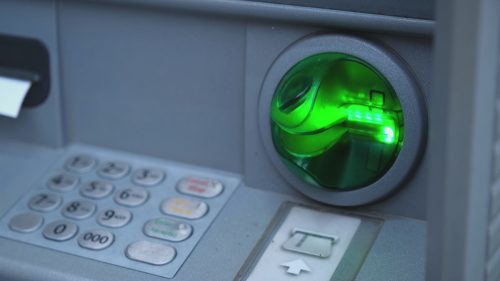
A loose fit isn’t the only telltale sign of tampering. Other oddities that may point to a credit card skimmer could include “misaligned pieces, sticky residue, or discoloration,” according to Amishav.
“If the terminal in question looks different from others nearby, that could indicate tampering,” he warns.
You should also check the shape of ATM card readers before using them, according to the FBI. The agency says a normal card reader is usually concave, which means it curves inwards. Skimmers, on the other hand, tend to curve outward in a more convex shape.
3. Feel the keypad.
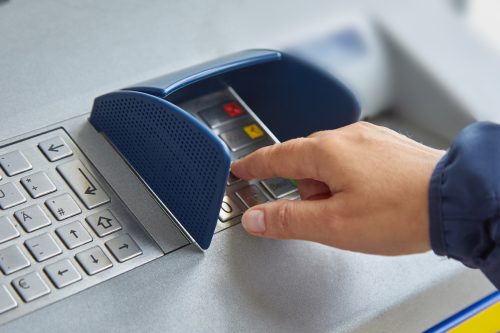
If the actual card reader isn’t compromised, the keypad could be. So make sure to be mindful of that, too.
“Sometimes, criminals add a fake keypad over the original to capture PINs,” Amishav says. “If the keypad feels thicker or spongier, proceed with caution.”
4. Check for cameras.
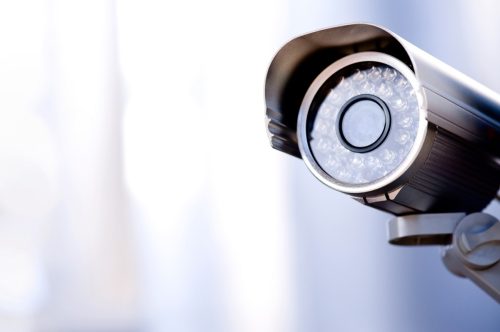
Scammers may use a hidden camera alongside the skimmer device to record customers’ PIN numbers, according to the FBI. These cameras are generally hidden on the front of a machine or somewhere nearby, like a light fixture.
With that in mind, Latham advises readers to “keep an eye out for any suspicious holes or objects that could conceal a camera aimed at recording PIN entries.”
RELATED: Police Reveal How to “Feel” Gift Cards to Avoid Getting Scammed.
5. Use your phone’s Bluetooth.
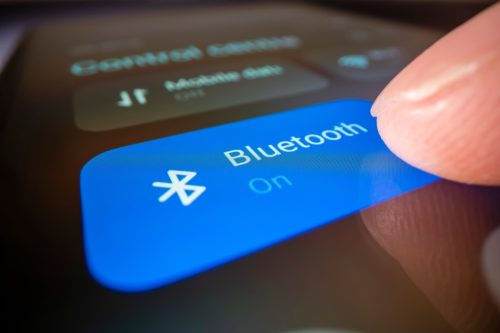
Your phone’s Bluetooth feature might be able to spot a skimmer if the device is broadcasting a signal to transmit stolen data, according to Latham.
“Activate Bluetooth on your phone and scan for nearby devices,” he recommends. “Skimmers may appear as unusual or unfamiliar device names in your Bluetooth settings, often as a string of numbers and letters.”
But if nothing pops up, that doesn’t guarantee that the payment terminal hasn’t been compromised.
“While this method can indicate the presence of a skimmer, it is not foolproof since not all skimmers use Bluetooth and other devices may also show similar identifiers,” Latham cautions. “Combine this technique with physical checks of card readers and vigilant observation of your surroundings.”
6. Take note of the terminal’s tapping technology.
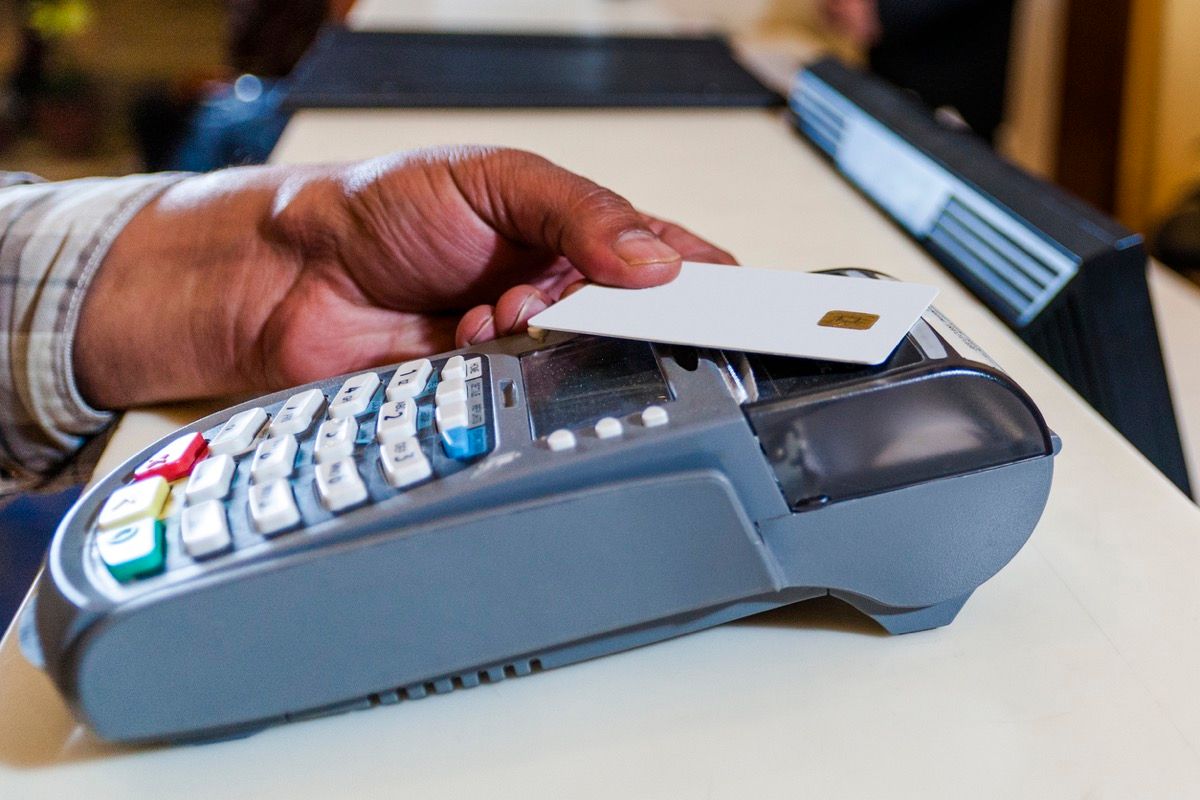
Wes Kussmaul, a cybersecurity and privacy expert who founded The Authenticity Alliance, suggests tapping your card instead of swiping it to prevent scammers from accessing the unencrypted information in your magnetic stripe.
“Tapping uses AC technology, which generates a unique encryption code for each transaction,” he explains. “That makes it nearly impossible for fraudsters to steal your card information.”
But defaulting to this form of payment could also help you more easily spot a credit card skimmer.
“If a payment terminal has a tap icon but tapping doesn’t work, it may have been compromised by a skimmer,” Kussmaul shares. “In that case, it’s especially important not to resort to swiping the card.”
7. Watch out for broken security tape.
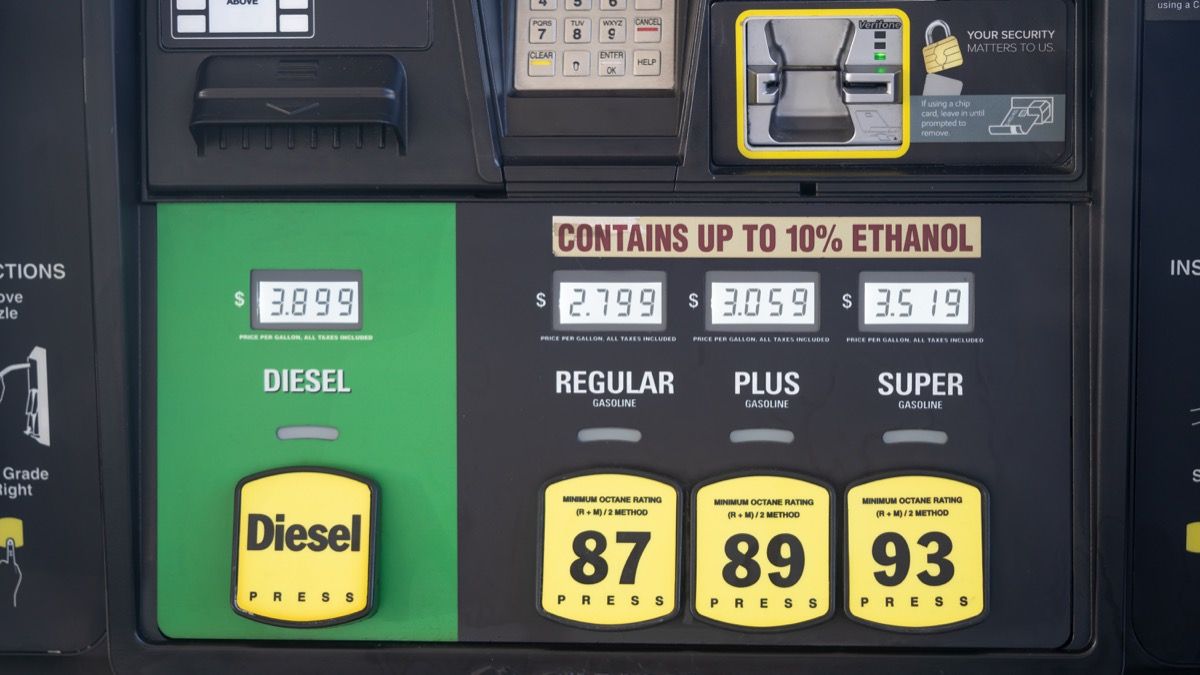
Since gas stations are one of the most common targets for credit card skimmers, employees will often place security tape or stickers over the panel of each pump as an “additional security measure,” according to Ryze.
“If you find these stickers ripped or broken, I advise you to resist from using the card reader,” he urges.
You may also see the word “void” on one of these labels if the pump panel has been opened, “which means the machine has been tampered with,” according to the Federal Trade Commission (FTC).
RELATED: 5 Biggest Mail Scams Happening Right Now—and How to Stay Safe.
What Can You Do If Your Card Has Been Skimmed?

The use of credit card skimmers is continuing to grow rapidly in the U.S. A recent report from the data analytics company FICO said there was “significant increase in compromised cards resulting from skimming activity” last year, with the total number of compromised debits cards in particular rising 96 percent from 2022.
“If you suspect your card has been skimmed, it’s important act swiftly to mitigate potential damages,” Latham says.
Most financial institutions will give you 60 days to report any fraudulent activity and avoid liability, according to Paige Hanson, digital consumer safety expert and co-founder of SecureLabs.
“So regular monitoring of your transactions is crucial for early detection,” she notes.
If you spot any unauthorized transactions, report them to your institution immediately. You should also contact the FTC to file an Identity Theft Affidavit.
“This documents your case officially and aids in further protections,” Hanson explains.
But even if you don’t notice any unauthorized transactions, you can still contact your bank to report suspected fraud “if you’re worried you inserted a card into a skimmer before realizing it,” Pierce shares.
“They’ll deactivate your card and send you a new one for extra peace of mind,” he says.
Still worried? “Consider changing your PIN and online banking passwords as well to enhance your security,” Latham suggests.
RELATED: 5 Times You Should Cancel a Credit Card, According to Financial Experts.
Wrapping Up
That’s it for our expert-backed guide on how to spot a credit card skimmer so you can keep yourself and your funds safe. But be sure to check back with us soon for more safety tips that can make all the difference when it comes to protecting the money in your accounts.
RELATED: For more up-to-date information, sign up for our daily newsletter.
- Source: FBI: Skimming
- Source: FTC: Best Practices to Foil Gas Station Skimmers